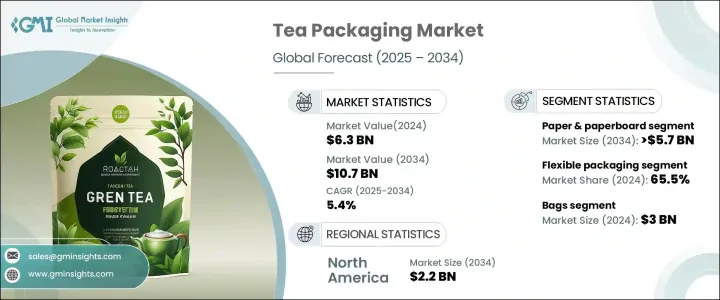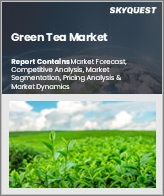
|
시장보고서
상품코드
1708219
차 포장 시장 기회, 성장 촉진요인, 산업 동향 분석, 예측(2025-2034년)Tea Packaging Market Opportunity, Growth Drivers, Industry Trend Analysis, and Forecast 2025 - 2034 |
||||||
세계의 차 포장 시장은 2024년에 63억 달러에 달하며, 2025-2034년에 CAGR 5.4%로 성장할 것으로 예측됩니다.
이러한 성장에는 전 세계 차 소비량 증가, 즉석 음료 선택의 급속한 확대, 고급 차 제품에 대한 수요 증가가 기여하고 있습니다. 차는 여전히 세계에서 두 번째로 많이 소비되는 음료이기 때문에 포장 제조업체들은 비용 효율성을 유지하면서 신선도와 향을 유지할 수 있는 혁신적인 고품질 솔루션을 지속적으로 개발해야 합니다. 현대의 차 소비자들은 지속가능성을 우선시하고 있으며, 생분해성 및 재활용 가능한 소재를 사용한 포장에 대한 요구가 증가하고 있습니다. 이러한 환경적 선호에 부합하는 브랜드들은 친환경 포장 솔루션을 채택함으로써 경쟁력을 높이고 있습니다.

또한 유기농 차 및 스페셜티 차의 인기가 높아짐에 따라 제품의 고품질 특성을 반영하는 프리미엄 포장에 대한 수요가 증가하고 있습니다. 재밀봉 옵션, 습기 차단, 빛으로부터의 보호 기능을 통합한 포장 디자인은 제품의 수명을 보장하고 소비자 경험을 향상시키는 표준 기능으로 자리 잡고 있습니다. 전 세계 차 소비 동향이 건강한 라이프스타일을 지향하고 특수 음료에 대한 관심이 높아짐에 따라 고급적이고 지속가능한 포장 솔루션에 대한 요구가 시장의 큰 성장을 가속할 것으로 예측됩니다. 또한 E-Commerce의 부상으로 인해 제품의 무결성을 유지하면서 운송의 어려움을 견딜 수 있는 견고하고 매력적이며 기능적인 포장에 대한 요구가 증가하고 있습니다.
| 시장 범위 | |
|---|---|
| 시작연도 | 2024년 |
| 예측연도 | 2025-2034년 |
| 시작 금액 | 63억 달러 |
| 예상 금액 | 107억 달러 |
| CAGR | 5.4% |
차 포장 시장은 플라스틱, 종이/판지, 금속, 기타 등 재료별로 분류됩니다. 종이 및 판지 부문은 생분해성 및 재활용 가능한 포장재에 대한 선호도가 높아짐에 따라 2034년까지 57억 달러 규모 시장을 창출할 것으로 예측됩니다. 많은 차 브랜드들이 경량성, 퇴비화 및 재활용이 가능한 종이 기반 포장재로 전환하고 있습니다. 프리미엄 브랜드와 스페셜티 브랜드도 친환경 브랜드 이미지에 부합하고 지속가능한 관행에 대한 소비자의 기대에 부응하기 위해 종이팩을 채택하고 있습니다. 환경에 대한 소비자의 인식이 높아지면서 퇴비화 및 재사용이 가능한 포장 옵션을 제공하는 브랜드는 고객 충성도를 높이고 시장에서의 차별화를 꾀할 수 있습니다.
연포장재는 경량성, 비용 효율성, 차 잎의 신선도 유지 능력으로 인해 2024년 65.5% 시장 점유율을 차지했습니다. 주로 라미네이트 필름, 파우치, 밀봉 가능한 백으로 만들어지는 이 유형의 포장은 습기, 산소, 빛에 대한 탁월한 보호 기능을 제공하여 찻잎이 오랫동안 품질을 유지할 수 있도록 보장합니다. 편의성과 유통기한 연장에 대한 수요가 증가함에 따라 특히 즉석 음료 및 특수 차에 대한 연포장 솔루션의 인기가 높아지고 있습니다.
북미 차 포장 시장은 프리미엄 차 및 유기농 차 제품의 인기 증가와 지속가능한 포장 솔루션에 대한 관심 증가에 힘입어 2034년까지 22억 달러에 달할 것으로 예측됩니다. 미국 시장만 보더라도 차 소비량 증가, 고급 유기농 제품으로의 전환, 친환경 포장에 대한 선호도 증가로 2034년까지 19억 달러 규모로 성장할 것으로 예측됩니다. 소비자들이 신선하고 믿을 수 있는 스페셜티 티를 찾는 가운데, 제품의 품질을 효과적으로 유지하는 포장 솔루션에 대한 요구가 그 어느 때보다 높아지고 있습니다.
목차
제1장 조사 방법과 조사 범위
제2장 개요
제3장 업계 인사이트
- 에코시스템 분석
- 업계에 대한 영향요인
- 촉진요인
- 차 소비량의 증가
- 지속가능 포장에 대한 수요 증가
- 차 제품의 프리미엄화
- E-Commerce의 확대
- RTD(ready-to-drink) 티의 인기 상승
- 업계의 잠재적 리스크 & 과제
- 지속가능성과 환경에 대한 우려
- 원재료 비용의 변동
- 촉진요인
- 성장 가능성 분석
- 규제 상황
- 기술 상황
- 향후 시장 동향
- 갭 분석
- Porter의 산업 분석
- PESTEL 분석
제4장 경쟁 구도
- 서론
- 기업 점유율 분석
- 주요 시장 기업의 경쟁 분석
- 경쟁 포지셔닝 매트릭스
- 전략 대시보드
제5장 시장 추산·예측 : 재료별, 2021-2034년
- 주요 동향
- 플라스틱
- 종이·판지
- 금속
- 기타
제6장 시장 추산·예측 : 포장 유형별, 2021-2034년
- 주요 동향
- 연포장
- 경질 포장
제7장 시장 추산·예측 : 제품 유형별, 2021-2034년
- 주요 동향
- 백
- 파우치
- 스틱 팩 & 사쉐
- 자(Jars)·용기
- 상자·카톤
- 기타
제8장 시장 추산·예측 : 지역별, 2021-2034년
- 주요 동향
- 북미
- 미국
- 캐나다
- 유럽
- 독일
- 영국
- 프랑스
- 스페인
- 이탈리아
- 아시아태평양
- 중국
- 인도
- 일본
- 뉴질랜드
- 한국
- 라틴아메리카
- 브라질
- 멕시코
- 중동 및 아프리카
- 사우디아라비아
- 남아프리카공화국
- 아랍에미리트
제9장 기업 개요
- Amcor plc
- Berry Global Inc.
- Constantia Flexibles
- Coveris
- Duropack Limited
- Huhtamaki
- Mondi
- Printpack
- ProAmpac
- Sappi
- Sonoco Products Company
- SPG-Pack
- Sprinpak
- Swisspac Packaging
- Transcontinental Inc.
- WestRock Company
- Winpak LTD.
The Global Tea Packaging Market was valued at USD 6.3 billion in 2024 and is projected to grow at a CAGR of 5.4% between 2025 and 2034. This growth is fueled by the rising global consumption of tea, the rapid expansion of ready-to-drink options, and the increasing demand for premium tea products. As tea remains the second most widely consumed beverage globally, packaging manufacturers are under constant pressure to develop innovative and high-quality solutions that preserve freshness and aroma while maintaining cost-effectiveness. Modern tea consumers prioritize sustainability, driving the need for packaging made from biodegradable and recyclable materials. Brands that align with these environmental preferences are gaining a competitive edge by adopting eco-friendly packaging solutions.

Additionally, the growing popularity of organic and specialty teas is accelerating the demand for premium packaging that reflects the high-quality nature of the product. Packaging designs that incorporate resealable options, moisture barriers, and light protection are becoming standard features, ensuring product longevity and enhancing the consumer experience. As global tea consumption trends point toward healthier lifestyles and increased interest in specialty beverages, the need for advanced and sustainable packaging solutions is expected to drive substantial market growth. Moreover, the rise of e-commerce has increased the need for sturdy, attractive, and functional packaging capable of withstanding the rigors of shipping while maintaining product integrity.
| Market Scope | |
|---|---|
| Start Year | 2024 |
| Forecast Year | 2025-2034 |
| Start Value | $6.3 Billion |
| Forecast Value | $10.7 Billion |
| CAGR | 5.4% |
The tea packaging market is categorized by materials, including plastic, paper and paperboard, metal, and others. The paper and paperboard segment is expected to generate USD 5.7 billion by 2034, driven by the increasing preference for biodegradable and recyclable packaging. Many tea brands are shifting toward paper-based packaging due to its lightweight, compostable, and recyclable nature. Premium and specialty brands are also embracing crafted paperboard cartons to align with their environmentally friendly brand image and meet consumer expectations for sustainable practices. As consumer awareness around environmental impact grows, brands that offer compostable and reusable packaging options are experiencing higher customer loyalty and market differentiation.
Flexible packaging held a dominant 65.5% market share in 2024 due to its lightweight nature, cost-effectiveness, and superior ability to preserve the freshness of tea. This type of packaging, often made from laminated films, pouches, and resealable bags, provides exceptional protection against moisture, oxygen, and light, ensuring the tea maintains its quality for extended periods. As the demand for convenience and longer shelf life grows, flexible packaging solutions are becoming increasingly popular, especially for ready-to-drink and specialty teas.
The North America Tea Packaging Market is expected to reach USD 2.2 billion by 2034, propelled by the rising popularity of premium and organic tea products and a growing emphasis on sustainable packaging solutions. The U.S. market alone is forecasted to grow to USD 1.9 billion by 2034, driven by increased tea consumption, a shift toward higher-end organic products, and an ongoing preference for eco-conscious packaging. As consumers demand specialty teas that maintain freshness and authenticity, the need for packaging solutions that effectively preserve product quality has never been higher.
Table of Contents
Chapter 1 Methodology and Scope
- 1.1 Market scope and definitions
- 1.2 Research design
- 1.2.1 Research approach
- 1.2.2 Data collection methods
- 1.3 Base estimates and calculations
- 1.3.1 Base year calculation
- 1.3.2 Key trends for market estimation
- 1.4 Forecast model
- 1.5 Primary research and validation
- 1.5.1 Primary sources
- 1.5.2 Data mining sources
Chapter 2 Executive Summary
- 2.1 Industry 3600 synopsis
Chapter 3 Industry Insights
- 3.1 Industry ecosystem analysis
- 3.2 Industry impact forces
- 3.2.1 Growth drivers
- 3.2.1.1 Rising tea consumption
- 3.2.1.2 Growing demand for sustainable packaging
- 3.2.1.3 Premiumization of tea products
- 3.2.1.4 Expansion of e-commerce
- 3.2.1.5 Rising popularity of ready-to-drink (RTD) teas
- 3.2.2 Industry pitfalls and challenges
- 3.2.2.1 Sustainability and environmental concerns
- 3.2.2.2 Fluctuating raw material costs
- 3.2.1 Growth drivers
- 3.3 Growth potential analysis
- 3.4 Regulatory landscape
- 3.5 Technology landscape
- 3.6 Future market trends
- 3.7 Gap analysis
- 3.8 Porter's analysis
- 3.9 PESTEL analysis
Chapter 4 Competitive Landscape, 2024
- 4.1 Introduction
- 4.2 Company market share analysis
- 4.3 Competitive analysis of major market players
- 4.4 Competitive positioning matrix
- 4.5 Strategy dashboard
Chapter 5 Market Estimates and Forecast, By Material, 2021 – 2034 ($ Mn & Kilo Tons)
- 5.1 Key trends
- 5.2 Plastic
- 5.3 Paper & paperboard
- 5.4 Metal
- 5.5 Others
Chapter 6 Market Estimates and Forecast, By Packaging Type, 2021 – 2034 ($ Mn & Kilo Tons)
- 6.1 Key trends
- 6.2 Flexible packaging
- 6.3 Rigid packaging
Chapter 7 Market Estimates and Forecast, By Product Type, 2021 – 2034 ($ Mn & Kilo Tons)
- 7.1 Key trends
- 7.2 Bags
- 7.3 Pouches
- 7.4 Stick pack & sachets
- 7.5 Jars & containers
- 7.6 Boxes & cartons
- 7.7 Others
Chapter 8 Market Estimates and Forecast, By Region, 2021 – 2034 ($ Mn & Kilo Tons)
- 8.1 Key trends
- 8.2 North America
- 8.2.1 U.S.
- 8.2.2 Canada
- 8.3 Europe
- 8.3.1 Germany
- 8.3.2 UK
- 8.3.3 France
- 8.3.4 Spain
- 8.3.5 Italy
- 8.4 Asia Pacific
- 8.4.1 China
- 8.4.2 India
- 8.4.3 Japan
- 8.4.4 ANZ
- 8.4.5 South Korea
- 8.5 Latin America
- 8.5.1 Brazil
- 8.5.2 Mexico
- 8.6 Middle East and Africa
- 8.6.1 Saudi Arabia
- 8.6.2 South Africa
- 8.6.3 UAE
Chapter 9 Company Profiles
- 9.1 Amcor plc
- 9.2 Berry Global Inc.
- 9.3 Constantia Flexibles
- 9.4 Coveris
- 9.5 Duropack Limited
- 9.6 Huhtamaki
- 9.7 Mondi
- 9.8 Printpack
- 9.9 ProAmpac
- 9.10 Sappi
- 9.11 Sonoco Products Company
- 9.12 SPG-Pack
- 9.13 Sprinpak
- 9.14 Swisspac Packaging
- 9.15 Transcontinental Inc.
- 9.16 WestRock Company
- 9.17 Winpak LTD.



















